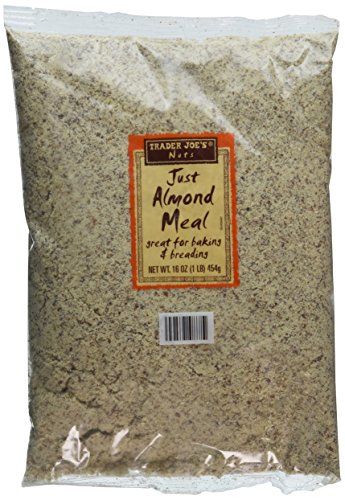Attention, Keto Dieters: Almond Flour Is Ridiculously Low In Carbs
Walk into your local Whole Foods or Trader Joe’s these days and it’s almond flour-based everything. From cookies to crackers, these wheat-free eats certainly seem better for you—but is almond flour really that nutritious?
“Besides having a slightly nutty, yet subtle flavor, almond flour is on fire because it’s gluten-free andcontains more protein than regular flour,” says Bonnie Taub-Dix, RDN, nutritionist and author of Read It Before You Eat It.
In addition to being a good-for-you option, almond flour is also super simple to use. “I love to bake with almond flour because it’s an easy one-for-one swap with flours of lesser nutritional value,” Taub-Dix says. “It also adds a richer flavor.” That’s why, when consulting with clients, Taub-Dix often recommends almond flour for baking, breading chicken or fish, or thickening soups.

Before you get in on its grain-free, nutty goodness, here’s what else you should know about almond flour, from its nutritional value to its best uses.
So, what is almond flour?
Typically, almond flour is made with blanched almonds (almonds that have been quickly boiled so that their skins can be removed), says Taub-Dix. Then, they’re pulverized into a fine powder using either a blender or food processor, and sifted into a fine powder, she says.
How does almond flour nutrition stack up?
Though almond flour doesn’t look too different than typical wheat flour, its nutrition couldn’t be farther from that of regular flour.
Here’s what you get in a quarter-cup serving of almond flour, according to the USDA:
- Calories: 170
- Fat: 15 g
- Saturated fat: 1 g
- Protein: 24 g
- Carbs: 6 g
- Fiber: 2 g
- Sugar: 1 g
- Sodium: 0 mg
- Calcium: 66 mg
- Iron: 1 mg
- Potassium: 190 mg
For reference, here’s what you get in a quarter-cup serving of white wheat flour, per the USDA:
- Calories: 114
- Fat: 0.3 g
- Protein: 3.2 g
- Carbs: 24 g
- Fiber: 0.9 g
- Sugar: 0.1 g
- Sodium: 0.6 mg
- Calcium: 4.7 mg
- Iron: 0.4 mg
- Potassium: 33.5 mg
Higher in fat, fiber, and protein than white flour (but lower in carbs), almond flour is also loaded with vitamin E, an antioxidant that aids in brain, eye, skin, and reproductive health.
It’s also high in magnesium, a mineral that can contribute to cardiovascular health and help prevent migraines. Plus, almond flour’s high niacin content is especially helpful for those suffering from inflammation associated with arthritis.
Almond flour’s health benefits don’t end there.
Thanks to its unique nutritional properties, almond flour offers a variety of other health benefits worth talking about.
1. It stabilizes blood sugar.
Due to its lower carbohydrate content, almond flour might help stabilize blood sugar levels, says Taub-Dix. Its high fat content also helps slow down the absorption of carbohydrates and sugar, another factor in keeping your blood sugar stable.
2. It’s heart-healthy.
Almonds and almond flour have been shown to decrease LDL (bad) cholesterol and increase HDL (good) cholesterol, says Taub-Dix—and high cholesterol is linked to an increased risk of heart disease.
3. It’s more satiating than typical flour.
Thanks to almond flour’s high fiber and protein content, it also helps to keep you feeling fuller for longer, says Taub-Dix. The perk: You’re better able to avoid cravings and feel more satisfied between meals.
4. Almond flour is great for people on low-carb or gluten-free diets.
If you live with a gluten intolerance or allergy, almond flour can literally change your life. “Almonds are naturally free of gluten, so almond flour opens up a world of possibilities, like baked goods, that might otherwise not be possible for those following gluten-free diets,” Taub-Dix says.
Not to mention, almond flour is also safe for those following keto or paleo diets, she adds. If you’re keeping a close eye on carbs, almond flour is a great go-to, with just four grams of net carbs (total carbs minus fiber) per serving, making it a great keto-friendly option. (Regular flour contains about 23 grams of net carbs per serving, knocking out much of your daily carb allowance on keto in one fell scoop.) Not to mention, almond flour’s higher fat content (15 grams per serving) also makes it a satiating ingredient for keto dieters.
How to add almond flour into your diet.
Impressed by almond flour’s nutrition? Thought so. Now it’s time to start loading up on the stuff.
Though almond flour is definitely a great candidate for baked goods like cakes and cookies, Taub-Dix encourages you to think outside the measuring cup, too.

“Use almond flour to create a rich sauce for a pot pie, thicken your soup, or bread your chicken or fish with almond flour,” she says.
How to find a quality almond flour.
Luckily, finding a quality almond flour to start playing around with isn’t too difficult these days.
According to Taub-Dix, almond flour should contain just one ingredient: blanched almonds.
 Pamela’s Almond Flouramazon.com$42.20SHOP NOW
Pamela’s Almond Flouramazon.com$42.20SHOP NOW
 Blue Diamond Almond Flouramazon.com$11.94SHOP NOW
Blue Diamond Almond Flouramazon.com$11.94SHOP NOW
 Trader Joe’s Just Almond Mealamazon.com$12.73SHOP NOW
Trader Joe’s Just Almond Mealamazon.com$12.73SHOP NOW
 Bob’s Red Mill Super-Fine Almond Flouramazon.com$46.29SHOP NOW
Bob’s Red Mill Super-Fine Almond Flouramazon.com$46.29SHOP NOW
If you can’t eat any gluten whatsoever, check your labels carefully to ensure your brand wasn’t produced in a facility that could have been contaminated with gluten.
You can always make your own almond flour…
On the next rainy day, use up some of that Costco-sized bag of almonds and DIY your own flour. First, blanch the almonds (quickly boil them in water) and remove their skins. Then, use a food processor or powerful blender to grind them into a fine, powdery texture, Taub-Dix says.
Just be sure to pulse your almonds for a few seconds at a time. Otherwise, you might whip them up into almond butter (though, TBH, there are worse things in the world than an accidental batch of homemade almond butter).
The bottom line: Almond flour is a great low-carb, gluten-free flour alternative with a nutty flavor and lots of protein and fiber.
Source: Read Full Article


